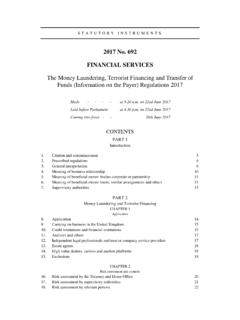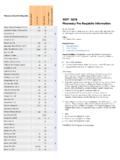Transcription of 2017 Global Information Security Workforce Study
1 2017 Global Information Security Workforce Study Benchmarking Workforce Capacity and Response to Cyber Risk A Frost & Sullivan Executive Briefing 2017 Global Information Security Workforce Study INTRODUCTION. Cybersecurity professionals worldwide face an ever-evolving threat landscape that many feel they are ill equipped to manage. Data breaches at corporations, educational institutions and government agencies continue to erode public confidence in the state of cybersecurity. The emergence of consumer goods such as wearable devices and self-driving cars, alongside the increasing connectivity of the systems managing critical infrastructure such as power plants and traffic signals are creating new threats to public safety, privacy, and economic stability.
2 The Center for Cyber Safety and Education partnered with (ISC)2 , Booz Allen Hamilton (Presenting sponsor), Alta Associates (Gold sponsor), and Frost & Sullivan to examine the state of the response to these developing risks in the 2017 Global Information Security Workforce Study (GISWS). This, the 8th edition of the Study , which has been running since 2004, reveals insights from an unprecedented number of respondents; 19,641. cybersecurity professionals representing 170 countries. This executive summary of the findings highlights their top concerns. Two thirds indicated that there are not enough cybersecurity workers in their organizations to meet the challenges they currently face.
3 This year's Study reveals we are on pace to reach a cybersecurity Workforce gap of million by 2022, a 20% increase over the forecast made in the 2015. It also reveals trends and insights into how hiring managers are responding and what organizations can do to attract, enable and retain the cybersecurity talent necessary to combat the risks in today's ever evolving threat environment. THREATS AND THREAT ACTORS. Threats have evolved rapidly in recent years, and are no longer the domain of a limited number of skilled individuals. The malware-for-hire phenomenon has substantially lowered the bar for cybercriminals as lacking the technical know-how is no longer a barrier for those that can rent a bot net, exploit kit, or ransomware package.
4 Overall cybersecurity professionals have to contend with an increasing velocity of malware hitting their networks at a relentless pace. The GISWS tracks the level of concern with which Security professionals regard particular threats. In 2017 , threats of most concern were as follows: Exhibit 1: Threats of Most Concern VULNERABILITIES ACTORS AND TACTICS. Broken authentication EXPLOITS Cyber terrorism and session management Data exfiltration Back doors Buffer overflows Insider threat Botnets Data exposure Organized crime DoS/DDoS. Injection vulnerabilities Social engineering Malware Security misconfiguration Proliferation of IoT. Ransomware Source: 2017 Global Information Security Workforce Study 2 All rights reserved 2017 Frost & Sullivan 2017 Global Information Security Workforce Study Globally, data exposure is the top concern for Information Security professionals, regardless of their geographic location.
5 There are, however, some regional discrepancies when considering other top-of-mind threats. Data exfiltration is a top worry in North America and APAC, however, in LATAM and Europe, ransomware is top of mind. In the Middle East & Africa, the broad act of hacking is identified as a primary concern, possibly suggesting professionals here are being affected by a broad set of motivations and outcomes. Exhibit 2: Top Concerns Globally EUROPE. Ransomware 28%. ASIA PACIFIC. NORTH AMERICA Data Exfiltration Data Exfiltration LATIN AMERICA. MIDDLE EAST & AFRICA. Hacking 37%. 35% Ransomware 47%. 44%. Source: 2017 Global Information Security Workforce Study , (n = 19,641).
6 The data clearly demonstrates much work is yet to be done to secure businesses, government agencies and organizations of all sizes, and the critical importance of having a properly staffed, agile and reactive Workforce . However, in the 2015 edition of the GISWS, 62% of Information Security workers reported having too few workers to address the threats they encountered. In 2017 , that number has ticked higher, with 66% indicating that they do not have the staff necessary to address the threats, indicating that the shortage of Information Security workers is widening, as more sectors recognize the importance of deploying a skilled cyber Workforce to protect their data.
7 UNDERSTANDING THE SKILLS GAP. In 2015, Frost & Sullivan forecasted a million worker shortage by 2020. In light of recent events and shifting industry dynamics, that forecast has been revised to a million worker shortage by 2022. This is reflected by the extraordinarily high number of professionals across the globe who indicate that there are not enough workers in their departments. Exhibit 3: Too Few Information Security Workers in My Department 66% 68% 67% 66% 67%. 61%. Global NORTH LATIN EUROPE MIDDLE EAST ASIA PACIFIC. AMERICA AMERICA & AFRICA. Source: 2017 Global Information Security Workforce Study , (n = 19,175). All rights reserved 2017 Frost & Sullivan 3.
8 2017 Global Information Security Workforce Study Workers cite a variety of reasons why there are too few Information Security workers, and these reasons vary regionally, however, globally the most common reason for the worker shortage is a lack of qualified personnel. Nowhere is this trend more common than in North America, where 68% of professionals believe there are too few cybersecurity workers in their department, and a majority believes that it is a result of a lack of qualified personnel. Exhibit 4: Reasons for Worker Shortage by Region Qualified Requirements not Business conditions Security No clear personnel difficult understood by can't support workers difficult Information Security to find leadership additional personnel to retain career path Global 49% 42% 41% 31% 31%.
9 NORTH. AMERICA 52% 42% 41% 34% 28%. LATIN. AMERICA 35% 45% 46% 21% 39%. EUROPE 48% 41% 39% 27% 31%. MIDDLE EAST. & AFRICA 40% 50% 45% 30% 39%. ASIA. PACIFIC 47% 40% 39% 33% 37%. Source: 2017 Global Information Security Workforce Study , (n = 12,709). Hiring is on the Rise There is good news in an industry that urgently needs to address its worker shortage: globally a third of hiring managers are planning to increase the size of their departments by 15% or more. A great deal of hiring will be concentrated in Europe, where 27% of hiring mangers intend to expand their department by 20% or more, and a total of 38% will grow their department by at least 15%.
10 The Middle East, Africa, and APAC can expect lower rates of hiring, however one in four hiring managers in each region still expect to see their departments grow by 15% or more. Exhibit 5: Hiring Managers Expecting to Increase Workforce by 15% or More By Region (Among Managers Expecting to Increase Workforce ). Increase by Increase by 16 20% more than 20%. Global 11% 20% 31%. NORTH AMERICA 11% 21% 32%. LATIN AMERICA 11% 19% 30%. EUROPE 11% 27% 38%. MIDDLE EAST & AFRICA 9% 18% 27%. ASIA PACIFIC 12% 15% 27%. Source: 2017 Global Information Security Workforce Study , (n = 2,906). Overall, 70% of hiring managers will increase their Workforce this year: 30% wish to expand by 20% or more.





